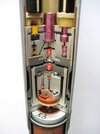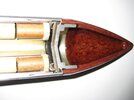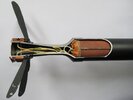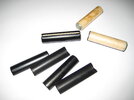microplastic
Well-Known Member
Cutaway model of a russian 57mm S-5P Chaff aircraft rocket. The rocket creates clouds of chaff that are intended to jam air defense radar or to decoy radar targeting missiles.
The rocket warhead has seven tubes, the 6 outer tubes are filled with metal-coated fiberglass strips, the central tube acts as a flash channel for blowing off the balistic cap. There are 4 chaff elements per tube (24 total),which are held together by two metal half-shells.
Below is the electric armed fuze with the distributor above it. The rocket motor is one powder stick in a steel tube with an elongated eight-fin exhaust nozzle at the rear.
When the rocket is fired, the rocket motor`s igniter receives an electrical pulse and ignites the motor igniter charge. The rocket motor burns for just 1.1 seconds and flies about 300 meters during this time. The wings fold out and bring the rocket to approx. 750rpm.
As the rocket motor is ignited, the two primer charges(1) of the base fuze are ignited at the same time, which in ignites a pyrotechnic delay(2) and the black-powder safety pellet(3) of the pin(5). The pin holds the slider(4) in safety position.The pin(5) can now move down, releasing the slider(4) and make the connection to the ignition pellet(6) .
The delay, when burned through, ignites the booster(7) and then the ignition pellet(6) which in ignites the ignition pellet(8) of the distributor. The flame ignites the center Detonator(9) which is sending a flame into the black powder expulsion charge in the top of the rocket, blowing up the ballistic cap. After a short delay(10), the six detonators(11) of the outer tubes are ignited, which ejects the chaff out of the now open tubes.
Length of the rocket : 1070mm
Diameter of the rocket : 57mm
Weight of the rocket : 4,04 kg
Fuzes of the warhead : I-90 + I-97
The rocket warhead has seven tubes, the 6 outer tubes are filled with metal-coated fiberglass strips, the central tube acts as a flash channel for blowing off the balistic cap. There are 4 chaff elements per tube (24 total),which are held together by two metal half-shells.
Below is the electric armed fuze with the distributor above it. The rocket motor is one powder stick in a steel tube with an elongated eight-fin exhaust nozzle at the rear.
When the rocket is fired, the rocket motor`s igniter receives an electrical pulse and ignites the motor igniter charge. The rocket motor burns for just 1.1 seconds and flies about 300 meters during this time. The wings fold out and bring the rocket to approx. 750rpm.
As the rocket motor is ignited, the two primer charges(1) of the base fuze are ignited at the same time, which in ignites a pyrotechnic delay(2) and the black-powder safety pellet(3) of the pin(5). The pin holds the slider(4) in safety position.The pin(5) can now move down, releasing the slider(4) and make the connection to the ignition pellet(6) .
The delay, when burned through, ignites the booster(7) and then the ignition pellet(6) which in ignites the ignition pellet(8) of the distributor. The flame ignites the center Detonator(9) which is sending a flame into the black powder expulsion charge in the top of the rocket, blowing up the ballistic cap. After a short delay(10), the six detonators(11) of the outer tubes are ignited, which ejects the chaff out of the now open tubes.
Length of the rocket : 1070mm
Diameter of the rocket : 57mm
Weight of the rocket : 4,04 kg
Fuzes of the warhead : I-90 + I-97







